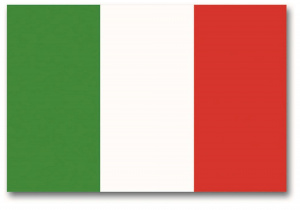Language/Italian/Grammar/Italian-Alphabet/en
 Հայերէն
Հայերէն Български език
Български език 官话
官话 官話
官話 Hrvatski jezik
Hrvatski jezik Český jazyk
Český jazyk Nederlands
Nederlands English
English Suomen kieli
Suomen kieli Français
Français Deutsch
Deutsch עברית
עברית हिन्दी
हिन्दी Magyar
Magyar Bahasa Indonesia
Bahasa Indonesia فارسی
فارسی 日本語
日本語 Қазақ тілі
Қазақ тілі 한국어
한국어 Lietuvių kalba
Lietuvių kalba Νέα Ελληνικά
Νέα Ελληνικά Şimali Azərbaycanlılar
Şimali Azərbaycanlılar Język polski
Język polski Português
Português Limba Română
Limba Română Русский язык
Русский язык Српски
Српски Español
Español العربية القياسية
العربية القياسية Svenska
Svenska Wikang Tagalog
Wikang Tagalog தமிழ்
தமிழ் ภาษาไทย
ภาษาไทย Türkçe
Türkçe Українська мова
Українська мова Urdu
Urdu Tiếng Việt
Tiếng Việt
Italian is a beautiful and complex language with a rich culture and history attached to it. In this lesson, we will learn about the Italian alphabet and pronunciation. Learning the Italian alphabet is the first step in learning the language. This lesson is part of the larger course titled "Complete 0 to A1 Italian Course" that aims to take complete beginners to the A1 level.
Overview[edit | edit source]
The Italian alphabet consists of 21 letters, excluding J, K, W, X, and Y. The Italian language uses both vowels and consonants. Each letter is assigned a specific pronunciation in Italian. In this lesson, we will go over each letter of the Italian alphabet, its pronunciation, and some useful cultural information attached to it.
The Italian Alphabet[edit | edit source]
Here is a table with each letter of the Italian alphabet, its pronunciation, and the corresponding English translation:
| Italian | Pronunciation | English |
|---|---|---|
| A (a) | /a/ or /aː/ | Apple |
| B (b) | /bi/ | Ball |
| C (c) | /tʃi/ as in "church" or /k/ as in "kite" | Cat |
| D (d) | /di/ | Dog |
| E (e) | /e/ or /ɛ/ | Elephant |
| F (f) | /ɛf/ | Fish |
| G (g) | /dʒi/ as in "giant" or /ɡ/ as in "goose" | Gorilla |
| H (h) | /akka/ | Hotel |
| I (i) | /i/ or /iː/ | Ice cream |
| L (l) | /ɛl/ | Lion |
| M (m) | /ɛmme/ | Monkey |
| N (n) | /ɛnne/ | Nurse |
| O (o) | /o/ or /ɔ/ | Orange |
| P (p) | /pi/ | Pineapple |
| Q (q) | /ku/ | Queen |
| R (r) | /ɛrre/ | Rainbow |
| S (s) | /ɛsse/ | Snake |
| T (t) | /ti/ | Tiger |
| U (u) | /u/ or /uː/ | Umbrella |
| V (v) | /vi/ | Violin |
| Z (z) | /zɛta/ | Zebra |
As you learn the Italian alphabet, it is essential to practice the correct pronunciation of each letter. However, please note that the Italian language has articulation differences that translate into vocalization changes. In other words, the pronunciation of the same letter changes depending on the context.
Also, keep in mind that many Italian words are borrowed from other languages, such as Latin, Greek, and French. Therefore, when you come across a word that has a different spelling, it might have a different pronunciation. Understanding the rules and the exceptions to them is fundamental for learning Italian pronunciation.
Conclusion[edit | edit source]
Congratulations on completing the lesson on the Italian alphabet and pronunciation. You now have the tools necessary to navigate the Italian language. Keep practicing the pronunciation of each letter, and remember, practice makes perfect!
Other lessons[edit | edit source]

